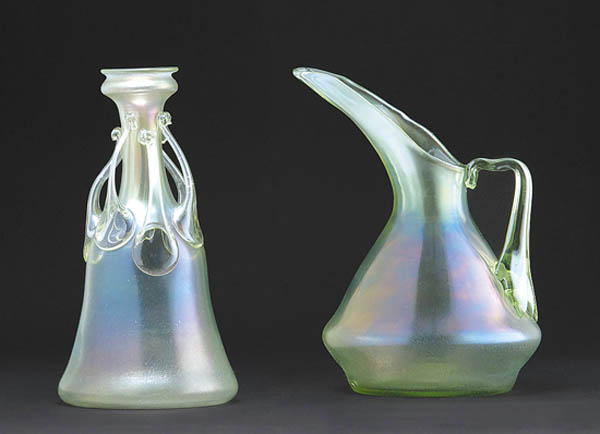Inventing the Modern World
Inventing the Modern World showcases objects painstakingly assembled from European and American collections. For co-curator Jason T. Busch, the exhibition represents a true achievement, since the exhibition checklist comprises decorative arts unattainable as a group in any one museum in the world. Co-curator Catherine L. Futter Futter adds, We looked at literally thousands of decorative arts from around the globe We kept refining our choices to find the objects that really spoke about innovation.
The decorative arts made for world's fairs often display an unusual tension: the use of traditional styles as a vehicle for progress, employing previously unknown materials and methods to craft works that evoke the aesthetics of prior art movements. Because early world's fairs were a gathering of nations in a less globalized time, works typically exhibited a nationalistic pride - while they showcased the most cutting-edge craftsmanship of a given country, they also spurred unprecedented exchange in industrial and artistic methods. According to Lynn Zelevansky, The Henry J. Heinz II Director of Carnegie Museum of Art, Inventing the Modern World embodies an inspirational vision, showcasing inventive design that marries art, science, and technology in the service of improving the human condition. The exhibition highlights this constant exchange, with extraordinary works that demonstrate how a certain amount of competition, ultimately, accelerates the pace of artistic innovation around the world.
Examples of new techniques first showcased at the fairs are countless. The simple forms of Leó Valentin Pantocsek's vase and ewer from around 1860, for example, belie its innovative genesis. The fascination with the iridescent surfaces of ancient Greek and Roman glass prompted many manufacturers to re-create it, but it was the Hungarian chemist Pantocsek who succeeded, applying metallic oxides to the hot glass surface to produce an iridescent coloring. The effect puzzled the minds of fair-goers at the 1862 London International Exhibition, as it was believed that only age could produce the effect. And, because the fairs spurred technological exchange, the technique soon spread. Two decades later, Louis Comfort Tiffany applied the same technology to his popular Favrile line of glassware, which will also be on display.
Pittsburgh, long a center of technological innovation, is well represented in the exhibition, notably by the Westinghouse Radio Broadcasting Panel shown at the 1933 Century of Progress International Exposition in Chicago. Featuring a world map with expanding circles, it illustrates the central importance of the United States, and especially KDKA Pittsburgh, the world's first commercial radio station. It reads Radio Broadcasting As Initiated By KDKA Has Made The Whole World A Neighborhood - 1920. Westinghouse used innovative materials to promote the company's products of mass communication, in this instance, Micarta - a new laminate composed of canvas, paper, and fiberglass - with accompanying designs in aluminum and steel, two materials that deeply resonate in Pittsburgh.
One of the most popular works displayed at the 1900 fair was the 1897 Five Swans tapestry designed by the German painter and printmaker Otto Eckmann. Influenced by both 19th-century Japanese and 15th-century German woodblock prints, Eckmann's tapestry embodies the cross-cultural exchange of the fairs. Enhanced by bold contrasts in color, the flattened and abstracted subjects and the meandering lines are rendered with a strong graphic composition.
The 1925 Paris exposition boasted a dazzling array of exquisite jewelry and luxury goods. Works from French jewelry firms such as Cartier and Boucheron were notable for their technical virtuosity and inventive combinations of materials, colors, and new processes. The dynamic pattern of the diamonds, rubies, sapphires, and emeralds in a bracelet by Boucheron demonstrates the firm's progressive designs and metalsmithing capabilities, illustrating historical and cross-cultural styles popular during the early 20th century. The impressive Art Deco brooch from Tiffany & Co.'s 1939 installation features an unusual combination of emeralds and newly fashionable champagne diamonds.
The 1925 exposition also displayed major innovations in glass, such as the centerpiece and bowls by J. & L. Lobmeyr. These striking objects showcase the technical and aesthetic expertise of the Austrian firm. In what was known as the Rare Earth Series, Lobmeyr actually incorporated uranium into the glass, causing the colors to change under different types of light.
A papier-mâché pianoforte and stool (1867) epitomize the remarkable inventiveness of the manufacturers of decorative arts. Although papier-mâché had been used in Europe for more than a century, the English firm Jennens & Bettridge introduced a dazzling array of complex techniques. Shown at the 1867 Paris fair, this instrument is made of seemingly fragile but highly durable glued and compressed paper pulp, applied sheet after sheet to a wooden core. Embellished with an ebonized surface adorned with gilding, mother-of-pearl, and panels of reverse-painted glass with foiled aluminum decoration, the pianoforte stands out as a significant integration of many decorative arts techniques.
The Sèvres Porcelain Manufactory Vase des Binelles, designed by Hector Guimard, closely relates to Paris's most distinctive Art Nouveau structures - the Metro station entrances that Guimard designed for the 1900 Paris exposition - in forms that resemble trees securely grounded in the earth. Its strong organic shape is enhanced by a sparkling green crystalline glaze. Standing four feet tall, Vase des Binelles was a feat in porcelain manufacture, impressing critics at the Louisiana Purchase International Exhibition in 1904 with its sheer scale and sophisticated design.
Staggering in its breadth, Inventing the Modern World: Decorative Arts at the World's Fairs, 1851-1939 evokes a time of exciting progress, and a series of world's fairs that were very different than they are today; these fairs focused squarely on products and design, whereas post-war fairs revolve around ideas. Early fairs showcased goods that were stronger, lighter, more durable, or colorful; different, but recognizable. By 1939, fairs showcased futuristic objects made of new materials like Pyrex, nylon, and stainless steel. Even so, the similarities between the 1851 and 1939 fairs and the objects within them are striking. The objects, according to Jason Busch, share themes that resonate throughout 'Inventing the Modern World', including technique, cross-cultural influence, and nationalistic inspiration, all of which shaped the competition inherent to the fairs. The look was different, but, as the show demonstrates, the quest for variety and difference, for innovation and ingenuity, remained a common thread from 1851 through 1939.
Inventing the Modern World: Decorative Arts at the World's Fairs, 1851-1939 opens at the Carnegie Museum of Art, Pittsburgh, October 13, 2012 and runs through February 24, 2013, then on to the New Orleans Museum of Art and the Mint Museum in Charlotte, North Carolina. A full-color catalogue, written by international scholars of 19th- and 20th-century decorative arts and co-published by Skira Rizzoli, accompanies the exhibition.
Jason T. Busch is Chief Curator and The Alan G. and Jane A. Lehman Curator of Decorative Arts and Design at Carnegie Museum of Art, Pittsburgh.
Catherine L. Futter is The Helen Jane and R. Hugh Pat Uhlmann Curator of Decorative Arts at The Nelson-Atkins Museum of Art, Kansas City.
A Design Symposium: The Art of Science: Invention and Innovation at the World's Fairs, 1851-1939 accompanies the exhibition. Taking place on Saturday, October 13, 9 a.m. to 3:30 p.m., the symposium features talks by the exhibition co-curators and other distinguished specialists in the field, plus a panel discussion and audience Q&A.
Jason T. Busch, Carnegie Museum of Art.
Located at 4400 Forbes Avenue in the Oakland section of Pittsburgh, Carnegie Museum of Art was founded by industrialist and philanthropist Andrew Carnegie in 1895. One of the four Carnegie Museums of Pittsburgh, it is nationally and internationally recognized for its distinguished collection of American and European works from the 16th century to the present. For more information about Carnegie Museum of Art, call (412) 622-3131 or visit the web site at www.cmoa.org.














